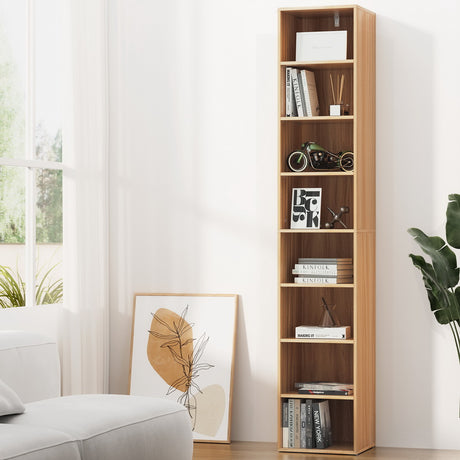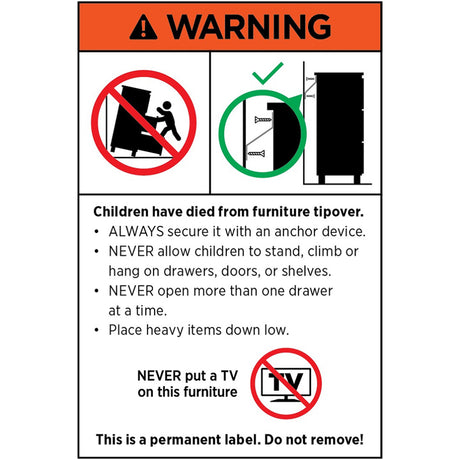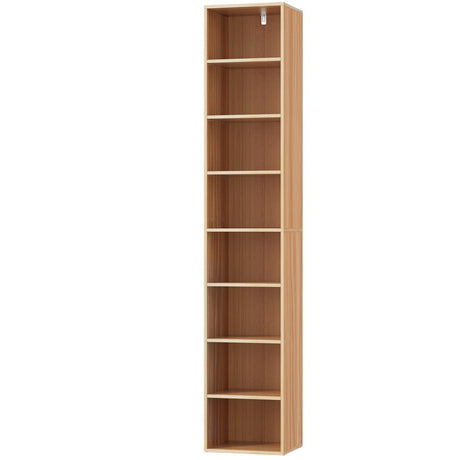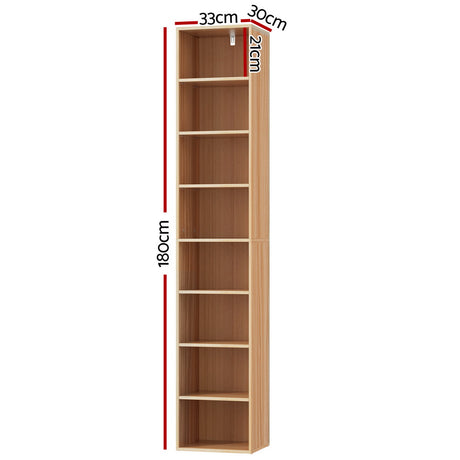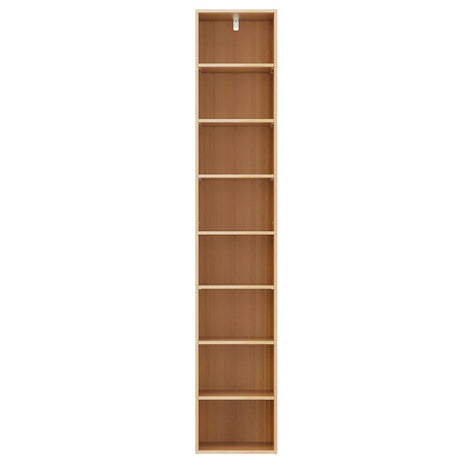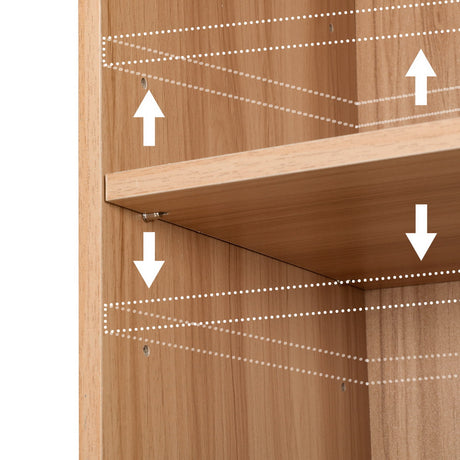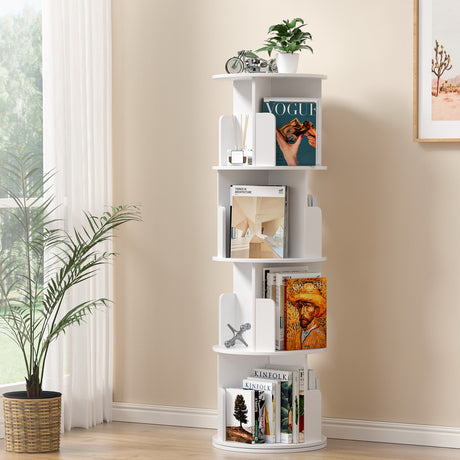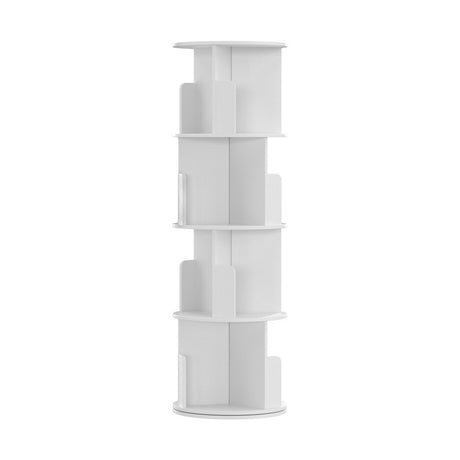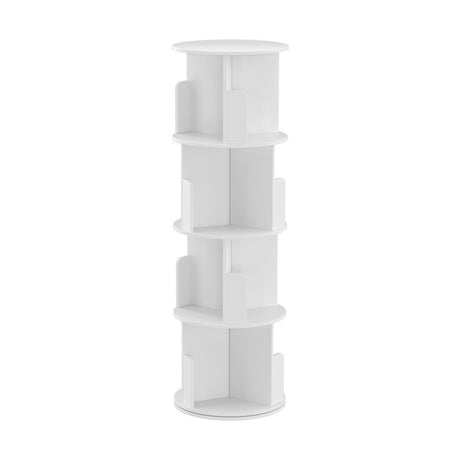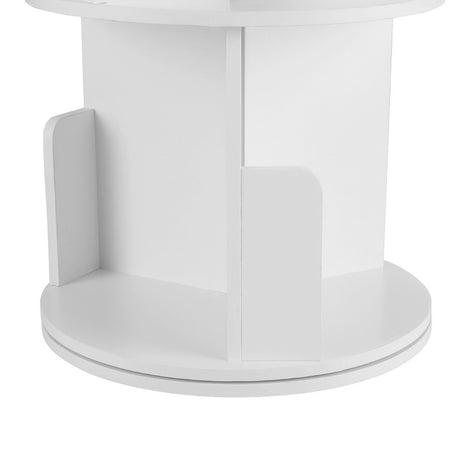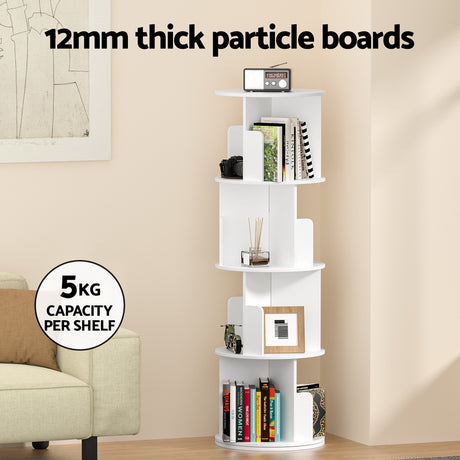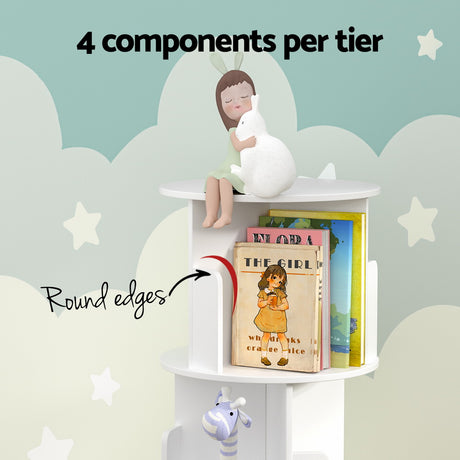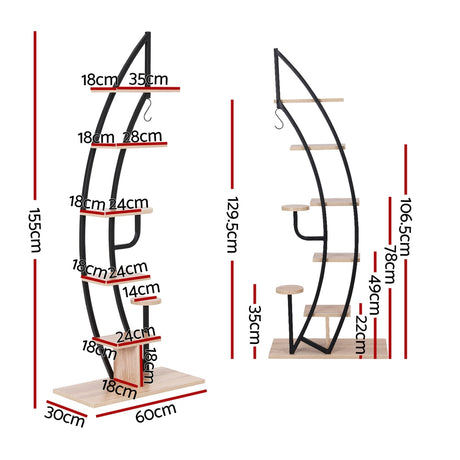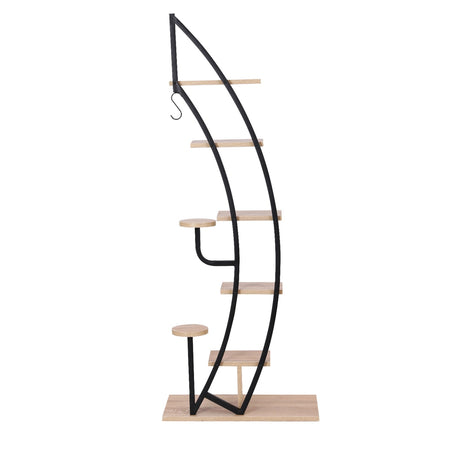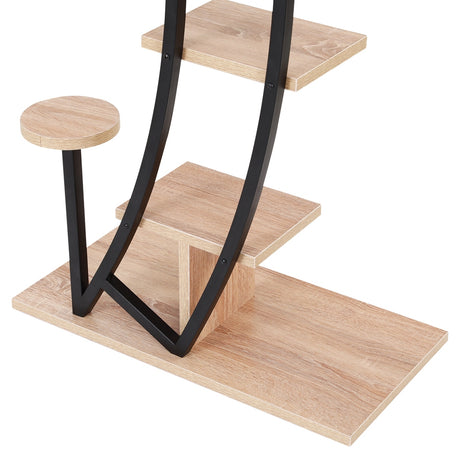Bookshelf wood units offer sturdy storage for books and decor, crafted from quality timber for durability and style. Ideal for organizing living rooms, offices, or study spaces. Shop the collection.
- 39% off
DDV462
Wooden Desk Monitor Riser Stand With 3Tier Storage Shelves Desktop Bookshelf(Walnut Wood(Style 02))
$54.99 AUD$89.99Unit price /UnavailableLow stock (20 units) - 39% off
DDV462
Wooden Desk Monitor Riser Stand With 3Tier Storage Shelves Desktop Bookshelf(White Wood(Style 02))
$54.99 AUD$89.99Unit price /UnavailableLow stock (19 units) - 31% off
During Days
Wooden Desk Monitor Riser Stand With 3Tier Storage Shelves Desktop Bookshelf(Walnut Wood(Style 01))
$47.99 AUD$69.99Unit price /UnavailableLow stock (20 units) - 31% off
During Days
Wooden Desk Monitor Riser Stand With 3Tier Storage Shelves Desktop Bookshelf(White Wood(Style 01))
$47.99 AUD$69.99Unit price /UnavailableLow stock (20 units) - 45% off
DDV1
Artiss Bookshelf 7 Tiers MILO Pine
$72.99 AUD$131.99Unit price /UnavailableIn stock (39 units) - 34% off
DDV1
Artiss Bookshelf 8 Tiers MILO Pine
$97.99 AUD$147.99Unit price /UnavailableIn stock (200 units) - 52% off
DDV1
Artiss Bookshelf 5 Tiers MILO Pine
$54.99 AUD$114.99Unit price /UnavailableIn stock (47 units) - 40% off
DDV1
Artiss Tree-Shaped Bookshelf ROMI Walnut
$82.99 AUD$137.99Unit price /UnavailableIn stock (192 units) - 44% off
DDV1
Artiss Bookshelf 5 Tiers ANTON Black
$114.99 AUD$204.99Unit price /UnavailableIn stock (160 units) - 36% off
DDV1
Artiss Bookshelf 3 Tiers 10 Cubes - CORA White
$103.99 AUD$161.99Unit price /UnavailableIn stock (141 units) - 44% off
DDV1
Artiss Bookshelf 4 Tiers EDIE White
$93.99 AUD$166.99Unit price /UnavailableIn stock (105 units) - 34% off
DDV1
Artiss Bookshelf Bookcase 4 Tiers LEOR Walnut
$93.99 AUD$142.99Unit price /UnavailableIn stock (74 units) - 39% off
DDV277
Wooden Wall Mounted Book Shelf Bear theme for children's room
$35.99 AUD$59.00Unit price /UnavailableVery low stock (2 units) - 39% off
DDV1
Artiss Plant Stand 6 Tier Ladder Corner Shelf
$68.99 AUD$112.99Unit price /UnavailableIn stock (200 units) - 36% off
DDV1
Artiss Tree Bookshelf 9 Tiers - ECHO Oak
$68.99 AUD$107.99Unit price /UnavailableIn stock (200 units) DDV728
Sleek 6-Tier Narrow Cube Shelving Unit for Home Office - 70.9 Inch Tall Bookcase
$494.99 AUDUnit price /UnavailableIn stock (100 units)DDV728
Extra Tall 7-Tier Rustic Brown Narrow Bookshelf for Small Spaces
$603.99 AUDUnit price /UnavailableIn stock (100 units)DDV178
Rustic brown and black steel Metal Frame 4 Tier bookshelf
$292.99 AUDUnit price /UnavailableIn stock (23 units)
Welcome to the Finest Bookshelf Wood Collection in Australia
Bookshelves are more than just functional pieces of furniture; they are a statement of style, organization, and sophistication in any space. At the heart of every remarkable bookshelf is the quality of its wood. Bookshelf wood refers to the specifically selected timber varieties known for their strength, durability, and aesthetic charm, making them ideal for constructing bookshelves suited to homes, offices, libraries, and commercial spaces. Whether you are an experienced carpenter, an interior designer, a DIY enthusiast, or simply a homeowner seeking the perfect way to showcase your literary treasures, choosing the right bookshelf wood is the first important step toward a stunning and lasting result.
Who Uses Bookshelf Wood and Why It’s So Popular
The appeal of bookshelf wood spans a diverse group of users. Cabinet makers and custom furniture designers prefer high-grade wood for its resilience and timeless appearance. Homeowners and renovators seek attractive, eco-friendly options to complement their interior décor. Even business owners and institutions rely on sturdy bookshelf wood to create organized, inviting environments. The surge in demand is linked to the growing popularity of open shelving, minimalist interiors, and natural materials that not only enhance visual spaces but also promise long-term reliability and eco-conscious value.
Trends and Relevance of Bookshelf Wood in Australia
Across Australia, there is a marked shift towards using native hardwoods and sustainably sourced timber, echoing both environmental responsibility and local craftsmanship. Nowadays, many Australians opt to buy bookshelf wood online for its convenience, access to a wider range of species—like Victorian Ash, Tasmanian Oak, and Jarrah—and the ability to customize finishes according to personal tastes. The current trend also emphasizes unique grain patterns and natural textures, with “live edge” and natural finish woods making a strong comeback. Versatility, sustainability, and style have thus made bookshelf wood in Australia more in demand than ever, as people look to create bespoke shelving solutions that are as beautiful as they are practical.
Why Buy Bookshelf Wood Online?
Shopping online for bookshelf wood opens up a world of options in terms of size, finish, and wood type, along with expert support and reliable delivery across Australia. With easy access to detailed product information, customer reviews, and professional advice, customers can confidently find top bookshelf wood products tailored to every project and budget.
What to Expect in Our Bookshelf Wood Guide
Ready to find the perfect wood for your bookshelf project? In this comprehensive guide, we’ll explore the best types of bookshelf wood available in Australia, provide expert tips on selection and finishes, and showcase inspiring ideas to spark your creativity. Let’s embark on your journey to create beautiful, durable shelving that truly stands out.
Why Choose Bookshelf Wood?
When it comes to furnishing a space, few materials match the natural charm, versatility, and resilience of bookshelf wood. Whether you are designing your dream living room, outfitting a modern office, or curating a stylish retail environment, selecting the best bookshelf wood in Australia offers a myriad of benefits that go beyond simple aesthetics. From its durability to affordability and eco-friendliness, bookshelf wood brings both beauty and utility to any setting.
Durability and Longevity
One of the top reasons homeowners, businesses, and designers choose bookshelf wood is its proven strength and longevity. Hardwood varieties such as oak, maple, and walnut not only provide superior support for heavy collections but also resist warping and sagging over time. This makes them a top bookshelf wood choice for locations where longevity is a key concern. Even softer woods like pine can offer lasting service with proper treatment, making affordability and durability go hand in hand.
Elegance and Customisation
Bookshelf wood is highly esteemed for its natural grains and textures, which introduce warmth and a unique character to any room. Whether you prefer minimalist modern lines or intricate traditional patterns, wood can be tailored to your personal style through staining, painting, or shaping. This versatility allows you to create custom solutions perfect for personal libraries, office displays, or boutique storefronts—each with a one-of-a-kind finish.
Sustainability and Environmental Benefits
For environmentally conscious buyers, many types of bookshelf wood are now sourced from sustainable forests or are reclaimed, ensuring that your beautiful shelving choices are also eco-friendly. Australian suppliers in particular often offer certified woods, so you can feel good about minimising your environmental footprint while investing in high-quality furniture.
Where and How to Use Bookshelf Wood
Bookshelf wood’s flexibility guarantees that it adapts seamlessly to a variety of residential, commercial, and personal use cases. Below are some of the most effective ways to integrate this material into your spaces.
Residential Applications
- Living Rooms & Home Libraries: The natural look of wood bookshelves provides a focal point for family spaces. Use affordable bookshelf wood to create built-in units for media, decor, and of course, your favourite books.
- Bedrooms: Floating wood shelves or corner bookcases make for charming, functional accents in bedrooms, offering both storage and decorative flair.
- Kitchens & Dining Rooms: Wooden shelves can display recipe books, ceramics, or unique dishware. Because these spaces encounter variable humidity, opt for well-sealed hardwoods for the best results.
Commercial and Office Use Cases
- Workplaces & Boardrooms: Using the best bookshelf wood in Australia can elevate professional spaces with elegant, executive-style shelving for books, awards, and important documents.
- Retail Stores: Wooden shelving perfectly displays products, adding warmth and a touch of sophistication to shop interiors. Custom woodwork can also reinforce branding and customer experience.
- Hospitality Venues: Hotels, cafés, and restaurants frequently use bookshelf wood for both functional storage and aesthetic appeal, from lobby bookcases to decorative accent shelves.
Personal and DIY Projects
Enthusiasts love working with bookshelf wood for DIY projects due to its availability and ease of handling. Craft unique pieces like foldable bookshelves, wall-mounted units, or mobile reading nooks using affordable bookshelf wood. Various wood types ensure options for every budget and taste, empowering creativity while delivering sturdy results for year-round use.
Choosing the Right Bookshelf Wood for Your Project
Whether you are revamping your home, equipping a corporate space, or crafting personal pieces, the selection of bookshelf wood directly impacts the result. Consider the weight capacity needed, your preferred finish, and the sustainability certifications of your chosen supplier. By carefully choosing the top bookshelf wood—whether it’s Tasmanian oak for its exquisite grain or pine for its value—you set the foundation for functional, beautiful furniture that endures.
Conclusion
Bookshelf wood’s natural beauty, durability, and design flexibility make it an excellent material for any project. From rustic and traditional to modern and sleek, bookshelf wood offers a design that matches your existing décor and meets the practical needs of your space.
Investing in a wooden bookshelf can enhance your living space and help organize your collection of books and decor. With countless options available, it’s essential to consider core features to make sure you’re selecting the Best Bookshelf Wood for your needs and budget. This guide explores the main factors to keep in mind, so you end up with a bookshelf that’s attractive, long-lasting, and suits your space perfectly.
1. Material Quality
The type and quality of wood are the biggest determinants of durability and aesthetic. Hardwoods like oak, maple, or walnut offer excellent strength and longevity but come at a higher Bookshelf Wood Price. Softwoods, such as pine, are cheaper and lighter but may dent or scratch more easily. If you’re seeking Cheap Bookshelf Wood, engineered woods and composite boards are cost-effective but may not deliver the same visual appeal or lifespan.
Tip: The Best Bookshelf Wood with premium hardwood will withstand heavy loads and resist warping over time, ensuring your investment lasts for years.
2. Build Technology & Craftsmanship
The construction method affects the stability and overall look. Look for bookshelves with:
- Dovetail joints or mortise-and-tenon connections for shelves and frame, which suggest high-quality craftsmanship.
- Reliable hardware (screws, cams, or brackets) that keeps the structure secure.
- Even surface finishes—smooth sanding and well-applied stains or paints indicate attention to detail.
Technology extends to modular designs, hidden fasteners, or adjustable shelving, enabling you to fit odd-sized books and rearrange shelves as your collection grows.
3. Durability & Weight Capacity
Durability is fundamental—your bookshelf should be capable of holding your heaviest books without sagging. Check weight specifications and consider reinforcement options, especially for larger units. The Best Bookshelf Wood with reinforced shelves can accommodate textbooks or art albums, while basic models are best for lighter novels and decor.
For added durability, look for:
- Thick solid shelves (at least 1 inch for longer spans)
- Back panels made from plywood or solid wood for stability
- Anti-tip hardware for safety, especially in households with children or pets
While Cheap Bookshelf Wood options may look attractive, always ensure they can handle your intended use.
4. Portability & Assembly
If you plan to move your bookshelf frequently or live in a rented space, weight and ease of assembly matter. Lightweight woods or engineered wood bookshelves are easier to transport, though they may not be as robust as heavy hardwoods.
- Flat-pack designs are great for portability and cost savings but may require more tools or time to assemble.
- Pre-assembled or partially-assembled options offer superior build quality and are ideal if portability is less of a concern.
Make sure instructions are clear, and check for the availability of all mounting and assembly hardware before buying.
5. Size, Style, and Comfort of Use
Measure your intended space to make sure your bookshelf fits without overcrowding. Consider how high you can comfortably reach and whether you need a wide or tall shelf. The Best Bookshelf Wood with adjustable shelves offers flexibility to accommodate books of all shapes and sizes, making organization easier and more enjoyable.
Style-wise, choose a finish and design that matches your existing décor: from rustic and traditional to modern and minimalist.
How to Choose the Right Bookshelf Wood: A Step-by-Step Buyer’s Guide
Looking for the perfect bookshelf starts with one crucial detail: selecting the right wood. Whether you want timeless beauty, long-lasting durability, or a wallet-friendly choice, buying bookshelf wood is a decision shaped by several key factors. This guide offers a clear, step-by-step process to help you make a confident, informed purchase with ease—so you’ll know exactly what to look for when browsing bookshelf wood for sale.
Step 1: Determine Your Budget
Your spending limit is the first, and often most decisive, filter. Bookshelf wood varies greatly in price, based on species, grade, and source.
- High-end woods (e.g., mahogany, walnut, cherry) offer unmatched beauty and longevity but come at a premium.
- Mid-range options (e.g., oak, maple, birch) strike a good balance between durability and cost.
- Budget-friendly choices (e.g., pine, plywood, MDF) suit lighter use or temporary spaces but may have a shorter lifespan.
- Think about your total project budget: includes wood, hardware, finish, and potential labor.
Step 2: Assess Your Space
The size and layout of your room will influence which bookshelf wood is best and how it's finished.
- Measure the area where the shelf will go. Look for top bookshelf wood styles that suit compact or spacious rooms accordingly.
- Consider wall color and overall lighting—light woods can brighten small or dark rooms, while dark woods add warmth to airy spaces.
- Check for possible moisture or temperature fluctuations that might require more stable woods (engineered or sealed solid wood).
Step 3: Identify Usage Frequency & Weight Load
Your bookshelf's daily workload shapes the durability you’ll need from your bookshelf wood choice.
- Light use: Decorative shelves or small book collections can use softer woods like pine or MDF.
- Heavy-duty use: For weighty textbooks or frequent rearranging, prioritize dense hardwoods such as oak, maple, or walnut.
- Factor in shelf thickness—thicker shelves resist sagging even with softer woods.
- If you expect to move often, look for lighter woods that are easy to disassemble and transport.
Step 4: Explore Design Preferences & Wood Appearance
Your shelf should complement your existing décor and personal style. When you buy bookshelf wood, picture the final look, not just the raw material.
- For a modern, minimalist look, choose smooth-grained woods (birch, maple) and uniform finishes.
- Traditional or rustic rooms pair well with pronounced grains (oak, ash, cherry) and visible knots or imperfections.
- Natural finishes highlight wood character, while painted or stained woods allow color customization.
- Ask to see actual samples or photos before making a purchase.
Step 5: Review Sustainability & Source
If eco-friendliness matters, you can still find top bookshelf wood that meets your ethics and quality standards:
- Look for FSC-certified or reclaimed wood for reduced environmental impact.
- Engineered wood (plywood, MDF) often makes use of fast-growing resources and can be finished to mimic real wood.
- Local woods may offer better value and reduce carbon footprint from shipping.
Step 6: Compare What’s Available: Quality and Reviews
Not all bookshelf wood for sale is equal. Before you commit:
- Check for warping, cracks, or other visible defects.
- Inquire about the wood’s moisture content; kiln-dried is less likely to split or warp over time.
- Read customer reviews or seek advice from woodworkers about brands or local suppliers.
- Balance price with longevity—sometimes it’s worth investing a bit more for a bookshelf that lasts decades rather than years.
Conclusion: Make a Confident, Personalized Choice
The right bookshelf wood can transform your space, offer lasting durability, and match your style. With careful consideration of your budget, space, usage needs, and sustainability preferences, you can select the perfect material for your bookshelf that will serve you for years to come.
Common Mistakes to Avoid When Buying Bookshelf Wood
Shopping for bookshelf wood online can be exciting, especially if you’re setting up your first home or looking to organize your reading space. However, there are some pitfalls first-time buyers and online shoppers often encounter. Before you add that “affordable bookshelf wood” to your cart, read on to learn about the most common mistakes—and how you can avoid them!
1. Overlooking Wood Quality and Type
One of the biggest cheap bookshelf wood problems is failing to research the quality and type of wood. Softwoods like pine may be affordable but often lack durability, while hardwoods like oak or walnut tend to last longer and support more weight. Always check if the product description specifies the wood type, and read reviews to ensure it stands up to daily use. If possible, buy bookshelf wood that clearly states its material and construction details.
2. Ignoring Dimensions and Room Fit
Photos can be deceiving when buying bookshelf wood online. Many first-time buyers assume the item will fit perfectly, only to discover it’s too big or small for their space. Before purchasing, measure the area where you plan to place the bookshelf and compare it against the product’s listed dimensions. Double-check for width, height, and depth to guarantee the perfect fit.
3. Underestimating Assembly Requirements
Affordable bookshelf wood often comes flat-packed, requiring self-assembly. Some buyers underestimate the complexity or lack the necessary tools. Read product details and customer reviews to gauge assembly difficulty. If you’re not handy, look for shelves labeled as “easy assembly” or consider options that offer assembly assistance.
4. Disregarding Weight Capacity
Many shoppers overlook the importance of weight limits, causing issues with sagging or collapsing shelves. This is a common affordable bookshelf wood mistake. Check for information about load-bearing capacity in the product specs. If you have lots of heavy books, prioritize sturdy hardwoods with reinforced shelving or thicker planks.
5. Forgetting About Finish and Maintenance
When buying bookshelf wood online, some customers focus only on appearance and price, neglecting the finish and required care. Certain finishes can affect the wood’s longevity and ease of cleaning. Look for protective coatings or treatments that resist moisture and stains. Review care instructions to ensure you’re prepared for any upkeep.
6. Not Checking Return Policies and Reviews
First-time buyers sometimes neglect to review store policies or customer feedback. If the bookshelf arrives damaged or isn’t as described, a poor return policy can make things difficult. Always review the seller’s return terms before purchasing and read user reviews for honest insights about the bookshelf’s durability, appearance, and assembly.
By avoiding these common mistakes, you can confidently shop for bookshelf wood online and find a piece that complements your space, stands the test of time, and fits your budget. Pay close attention to details and don’t be afraid to ask questions before buying.
Bookshelf Wood vs Similar Alternatives
Choosing the right material for your bookshelf is an essential step toward creating a durable and stylish storage solution for your books and décor. Bookshelf wood remains a popular material, but options such as metal shelving and particleboard have emerged as strong competitors. This comparison explores how bookshelf wood holds up against these alternatives in terms of function, cost, and overall value.
Bookshelf Wood: Natural and Classic
Bookshelf wood encompasses various hardwoods and softwoods like pine, oak, maple, or walnut that are commonly used to build bookshelves. Its timeless appearance and sturdy nature make it a preferred choice for traditional and modern interiors alike.
Alternative 1: Metal Bookshelves
Metal shelving has grown popular for its modern look, industrial aesthetic, and superior strength. Metals like steel or aluminum are used to create shelves that can bear significant weight and require minimal care.
Alternative 2: Particleboard/MDF Bookshelves
Particleboard and MDF (Medium Density Fiberboard) are engineered wood alternatives made from wood chips, fibers, or sawdust bonded with resin. These alternatives are often chosen for their affordability and ease of customization.
Bookshelf Wood Cost vs Metal and Particleboard: Price Comparison
| Material | Average Cost | Strength & Durability | Purpose & Appeal |
|---|---|---|---|
| Bookshelf Wood | $150–$900 (depending on wood type & finish) | High; long-lasting, repairable | Classic look, suits most interiors |
| Metal | $100–$600 | Very high; resistant to warping and pests | Modern, industrial; ideal for heavy loads |
| Particleboard/MDF | $50–$300 | Moderate to low; prone to sagging/moisture damage | Budget-friendly, often coated or painted |
Best Bookshelf Wood vs Alternatives: Pros and Cons
-
Bookshelf Wood
- Pros: Attractive grain patterns; can be refinished or repaired; very sturdy.
- Cons: Higher initial cost; heavier; requires periodic maintenance (polish, protection from pests).
-
Metal Shelves
- Pros: Lightweight yet strong; minimal maintenance; good for industrial or minimalist décor.
- Cons: Can be prone to rust (if untreated); less warm/organic feel.
-
Particleboard/MDF
- Pros: Cheapest option; available in many colors/finishes; lightweight.
- Cons: Easily damaged by water; not as durable; can sag over time.
Conclusion
When doing a Bookshelf Wood price comparison with alternatives like metal and particleboard, wood emerges as the best choice for aesthetics, durability, and long-term value—albeit at a premium. Metal shelving offers unmatched strength and a modern touch for a slightly lower price, while particleboard is best suited for temporary solutions or strict budgets. Your ultimate pick depends on budget, décor preferences, and the expected load your bookshelf will carry.



























